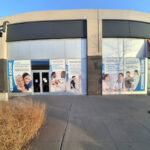Lung Cancer Treatment in Staten Island, NY
Lung cancer continues to be among the top five cancers diagnosed in the United States: it is estimated that one in 16 people will face this disease during their lifetime. The Oncology Department at Richmond University Medical Center (RUMC) offers comprehensive lung cancer treatment to ensure that patients receive state-of-the-art care. An award-winning healthcare facility, RUMC serves individuals on Staten Island, New York, and in the surrounding area. RUMC is known for its expert oncology services, first earning accreditation over 80 years ago from the American College of Surgeons’ Commission on Cancer, making its cancer care program the longest consecutively accredited program of its kind on Staten Island. Learn more about lung cancer and how it is diagnosed and treated.

What Is Lung Cancer?
Every cell in the body needs oxygen to function properly. When a person breathes, oxygen moves through their nose, down their trachea, and into the lungs, where it flows into tubes called bronchi. Then, oxygen cells move into the bloodstream and are carried throughout the body. Most types of lung cancer begin in the cells that line the bronchi.
Lung cancer develops when irregular cells grow into malignant tumors. Smoking and breathing in secondhand smoke cause the majority of lung cancer cases, as the carcinogens found in cigarette smoke damage cells within the lining of the lungs. However, many new lung cancer diagnoses are in patients who have never smoked or who quit smoking a long time ago. In some cases, the cause of lung cancer cannot be determined.
Types of Lung Cancer
There are two main types of lung cancer: non-small cell lung cancer (NSCLC) and small cell lung cancer (SCLC). NSCLC is the most common type of lung cancer. The cancer cells usually grow slowly, but they can spread to other parts of the body. Types of NSCLC include:
- Adenocarcinoma
- Adenosquamous carcinoma
- Sarcomatoid carcinoma
- Squamous cell carcinoma
SCLC, mostly found in heavy smokers, is more difficult to treat than NSCLC and usually spreads faster. If detected early, it is easier to treat. There are two types of SCLC: small-cell carcinoma and combined small-cell carcinoma.
Lung Cancer Causes and Risk Factors
Smoking is the primary cause of lung cancer, accounting for about 90% of cases, according to American Lung Association. Cigarette smoke contains carcinogens that damage the cells in the lung tissue. Over time, this damage can cause cells to grow and change abnormally, developing into cancer cells. But active smokers are not the only people who get lung cancer. Breathing in secondhand smoke can also put a person at risk of developing lung cancer. Other risk factors for lung cancer include:
- Radon gas exposure: Prolonged exposure to unhealthy levels of this naturally occurring gas can increase the risk of lung cancer. Most homes are tested for high radon levels.
- Workplace exposure: Some people work in professions where they are regularly exposed to cancer-causing substances, including asbestos and arsenic.
- Family history: If a patient has a close family member with lung cancer, they are more likely to develop the disease themselves.
- History of radiation therapy: Patients who have had radiation therapy in the chest area to treat other types of cancer may be at an increased risk of developing lung cancer.
- Air pollution: Long-term exposure to high levels of outdoor air pollution, such as exhaust fumes, can raise the risk of lung cancer.
A smoker’s risk of cancer increases with the number of cigarettes they smoke each and the number of years they have been a smoker. While there is a clear link between tobacco smoke and lung cancer, using electronic cigarettes or marijuana may also increase lung cancer risk.
Signs and Symptoms of Lung Cancer
In the early phases of lung cancer, a patient may not notice any symptoms. As lung cancer progresses, symptoms may include:
- A new and persistent cough
- Wheezing or hoarseness
- Shortness of breath, also known as dyspnea
- Chest or shoulder pain
- Coughing up blood
- Unexplained fatigue or weight loss
- Loss of appetite
- Headaches
- Bone pain
- Swollen lymph nodes in the chest
- Repeated bouts of pneumonia
A patient who notices one or more of these symptoms should speak with their primary care physician right away. As with most types of cancer, early detection and treatment are key.
How Lung Cancer Is Diagnosed
Several tests are used to confirm a diagnosis of lung cancer and determine which type of lung cancer a patient has. These tests can include:
- Imaging tests: A medical provider may order an X-ray or computer tomography (CT) scan to look for abnormal lesions or nodules on the lungs.
- Sputum cytology: This test analyzes the saliva and mucus that a patient is coughing up to check for the presence of cancer cells.
- Biopsy: A physician may take a small tissue sample from the lungs or lymph nodes to test cells for cancer.
Once a patient has been diagnosed with lung cancer, they may need additional testing to complete lung cancer staging. Lung cancer is graded on a scale of 0 to IV based on how much it has grown and spread. A physician may use additional imaging tests, such as a positron emission tomography (PET) scan or magnetic resonance imaging (MRI).
Lung Cancer Stages
The stages of NSCLC are:
- Stage 0: In this early stage, lung cancer is only in the lining of the lung or bronchi.
- Stage I: In this stage, cancer is growing in the lungs but has not yet spread to other parts of the body.
- Stage II: In Stage II, cancer may be spreading to nearby lymph nodes.
- Stage III: In Stage III, cancer has usually spread to the lymph nodes in the mediastinum, the area of the chest between the lungs that houses the heart.
- Stage IV: In this most advanced stage, lung cancer has spread to other parts of the body.
SCLC has just two stages: limited and extensive. In the limited stage, cancer is only present in one lung or has not spread to the lymph nodes. In the extensive stage, cancer has spread to the opposite lung or other organs.
Lung Cancer Treatment Options
Because of recent advances in cancer treatment, patients have more reason to be optimistic than ever before. Most patients with lung cancer will undergo both nonsurgical and surgical treatments, including radiation therapy, chemotherapy, or immunotherapy. There are several surgical methods for treating lung cancer, including:
- Wedge resection: This procedure removes a lung tumor and some of the tissue that surrounds it.
- Segmental resection: Also known as a segmentectomy, this procedure removes a tumor and a larger amount of healthy tissue than a wedge resection.
- Lobectomy: The right lung has three lobes; the left lung has two. A lobectomy is the surgical removal of an entire lobe that has tumors.
- Pneumonectomy: This is the surgical removal of part or all of one lung. Pneumonectomy is recommended if removing the entire lung can cure a patient’s cancer and stop it from spreading.
The experienced team of board-certified oncologists at Richmond University Medical Center uses minimally invasive techniques to stage and surgically remove cancerous tumors whenever possible. This means shorter hospital stays, less postoperative pain, and a faster return to day-to-day activities. Additionally, all cases requiring surgery are reviewed by our multidisciplinary tumor board to ensure treatment plans follow national guidelines.
Some patients will have adjuvant treatments such as chemotherapy before or after surgery. This helps ensure as many cancer cells are killed off as possible. No two patients are alike and an oncologist will walk a patient through all their available treatment options to come up with a plan that best suits their diagnosis.
Minimizing Lung Cancer Risk
The best thing a person can do to reduce their risk of lung cancer is to avoid tobacco smoke. No matter how many years a patient has been a smoker, quitting can improve their overall health. Other ways to reduce risk include lowering one’s exposure to radon, asbestos, and other harmful chemicals. People who work in industries where they are regularly exposed to carcinogens should always wear the proper personal protective equipment (PPE) to minimize their risk.
Patients who have a higher risk of lung cancer because of a history of smoking may want to consider an annual lung cancer screening. The recommended screening test is a low-dose CT scan that can detect abnormalities in the lungs.
Get More Information About Lung Cancer Treatment
With an experienced oncology team at Richmond University Medical Center, patients can feel confident that they are receiving the best lung cancer treatment available. The board-certified oncologists take the time to create a personalized treatment plan for each patient and are committed to providing the highest level of care.
Serving individuals throughout Staten Island, NY, Richmond University Medical Center offers onsite diagnostic testing, including PET scans and MRIs. The hospital also has a dedicated Center for Cancer Care so that patients can receive cutting-edge care without having to travel to away from Staten Island. For more information about cancer treatment at Richmond University Medical Center, or to request a referral from your physician, contact us today.



